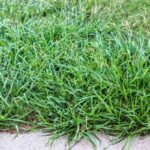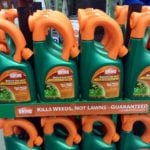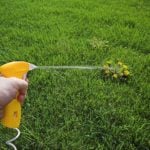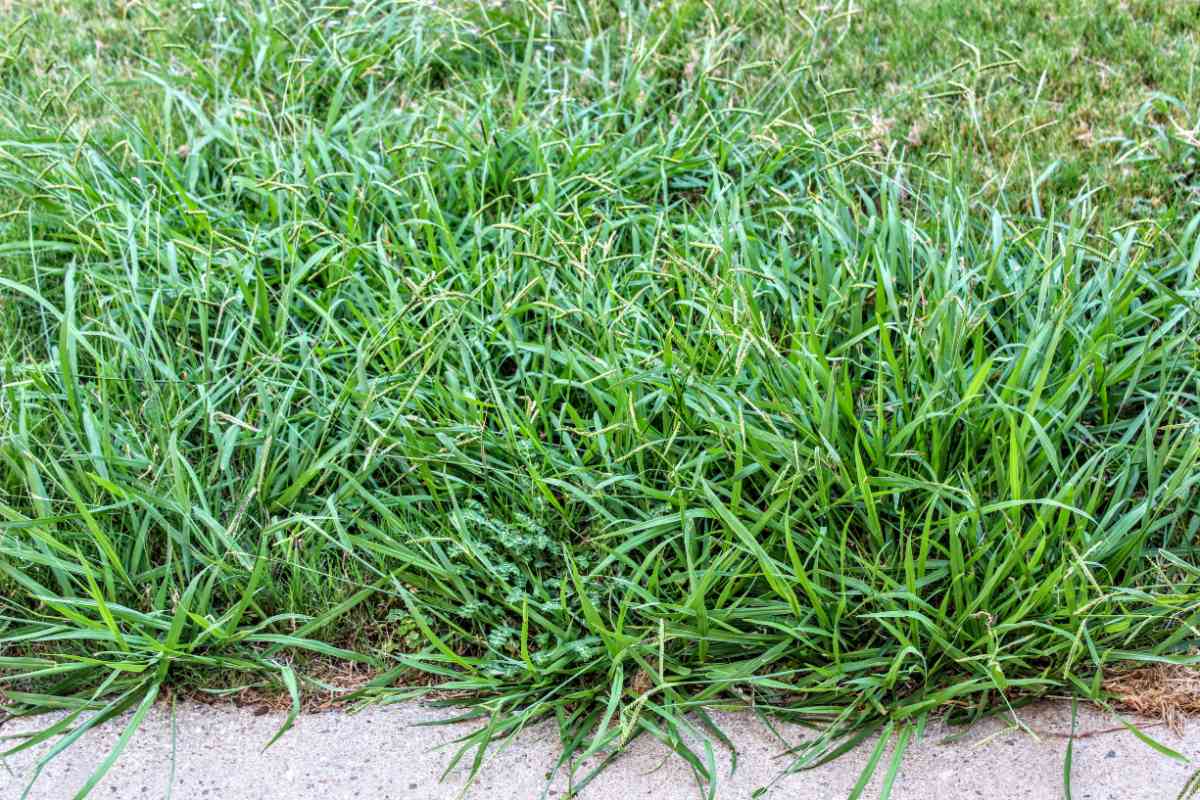
Do you stare angrily at sprouting patches of crabgrass or tear your hair out when dealing with dandelions? There’s a better way. Here’s when and how to use pre-emergent herbicides to kill your lawn’s weeds.
In this article, we’ll walk you through one of the two major classes of weed-killing chemicals — pre-emergent herbicides. You spread or spray pre-emergent products on your lawn, taking the fight directly to weed seedlings before they become an established nuisance in your lawn.
What is a Pre-Emergent Herbicide?
A pre-emergent herbicide is applied before weeds grow to keep them from becoming problematic in your lawn. According to North Carolina State University, pre-emergent herbicides prevent a weed’s roots, shoots, or both from establishing.
So, what does that mean?
It means pre-emergent herbicides don’t kill weed seeds or stop them from germinating. Instead, pre-emergents work by fatally interrupting the growth process in some way (often in the cell division stage) to prevent the seed from getting through the seed germination stage.
“Pre-emergence herbicides form the backbone of weed control programs,” says the University of Georgia Extension’s guide to weed control. “They do not control all weeds that may be present in a lawn, but they are effective for many of the most common lawn weeds.”
Dr. Rebecca Grubbs-Bowling, assistant professor and turfgrass specialist at Texas A&M University and author of “A Homeowner’s Guide to Herbicide Selection for Warm-Season Turfgrass Lawns,” says pre-emergent weed preventers are best suited for grassy weeds and annual weeds that reproduce by seeds. “They don’t work as well on perennials.”
If you already see weeds in your grass, check out our article on Applying Post-Emergent Herbicides to Your Lawn.
When to Apply Pre-Emergents

The key to success with pre-emergents is having them in the soil at the right time and soil temperature to disturb the seedling’s growth. Application dates differ depending on where you live and your local climates; when to use a pre-emergent also depends on the type of weed(s) you’re fighting.
Identifying your weeds is crucial to choosing the appropriate herbicide and application timing. Generally speaking, annual weeds are either winter or summer annuals. That means applying the product in spring for summer annuals and in fall for winter annuals.
You also can learn about your lawn’s health by knowing the type of weeds growing in your yard.
Spring Pre-Emergent Application: When the Soil Warms
For spring application of pre-emergents, “[t]he soil temperature (not air temperature) should be in the 50-55 degree range,” says Grubbs-Bowling.
This temperature range is critical for the herbicide to prevent summer annual weed seeds from establishing; many dormant seeds start germinating once soil temperatures hit 55 degrees Fahrenheit.
You can find localized soil temperature readings online or from your county’s Extension Service. For the most localized data, plunge a temperature gauge into the soil beneath your turf. You can find inexpensive soil temperature gauges online or at garden shops, or you can use a 3-inch meat thermometer.
Common spring-germinating weeds include:
- Crabgrass (Digitaria sanguinalis): A grassy weed that grows close to the ground and spreads rapidly. Check here to find out How to Get Rid of Crabgrass.
- Dandelions (Taraxacum officinale): Weeds with broad leaves and yellow flowers that transform into white puffy balls when they mature. Dandelions can benefit your yard and attract pollinators.
- Ragweed (Ambrosia artemisifolia): A plant that blooms in the summer and produces a large amount of pollen.
- Yellow foxtail (Setaria glauca): A summer annual with a seed head that resembles a bushy spike, similar to a fox’s tail.
- Sandbur (Cenchrus longispinus): A spreading summer annual weed commonly found in dense patches, particularly in sandy soils.
Fall Pre-Emergent Applications: When the Soil Cools
Winter annuals usually germinate in the fall, overwinter as small plants, and then proliferate as temperatures warm in the spring. To prevent these weeds from establishing, it is recommended to apply a second application of pre-emergence herbicide in early to late fall or early winter.
Ideally, the herbicide should be applied when the soil temperature is around 70 degrees Fahrenheit.
Some examples of winter germinating weeds with a delayed growing season in spring include:
- Chickweed (Stellaria media): A winter annual that grows in moist, cool, shaded areas. It has a shallow, fibrous root.
- Persian speedwell (Veronica persica): The stems of this winter annual are slender, turning upward at the tips as it grows.
- Annual bluegrass (Poa annua): The boat-shaped leaf tips and pale green leaves in spring help identify this weed.
- Cheatgrass (Bromus tectorum): A winter annual with a delicate, feathery appearance. Cheatgrass has slender, light-green stems that sag at the tips where the seeds form.
Spring and Fall Applications
There’s an exception to every rule. Depending on the species, some weeds like clover and spurge can be summer or winter annuals, biennial, or perennial. Because of this, you should apply in both spring and fall to control them.
- Clover (Trifolium repens): Many people have worked hard for a long time to keep clover out of their lawns, but you should reconsider eliminating it. Clover lawns have gained popularity as they are nitrogen-rich and pollinator-friendly.
- Spurge (Euphorbia spp.): This broadleaf weed family can be easily identified by its red hairy stem and dense mat of dark green leaves close to the ground.
How to Apply Pre-Emergents
Now that you know when to apply pre-emergent herbicides, there are a few steps you should take before applying them. By following these steps, you’ll be well-prepared to effectively apply pre-emergent herbicides and prevent weed growth in your lawn.
- Measure your lawn: Calculate the square footage of your lawn by multiplying the length and width of your lawn in feet. The best pre-emergent herbicides will indicate the coverage in square feet.
To calculate the square footage of your lawn, use the following formula:
Length of Lawn (in feet) x Width of Lawn (in feet) = Square Footage of Lawn
- Choose between granular and liquid: Consider the advantages and disadvantages of each type and choose the one that suits your preferences and needs. You may need specific equipment depending on the type of pre-emergent herbicide you choose.
- For granular herbicides, you’ll need a spreader to distribute the product evenly.
- For liquid herbicides, you’ll need a sprayer.
- Check the weather: An herbicide for lawns should be applied when the lawn is dry. You shouldn’t apply herbicides to wet areas.
- Read the label carefully: By law, herbicide labels must contain specific information on the ingredients, proper application, safety precautions, and product dangers. Although it’s hardly provocative prose, read the labels thoroughly.
“People just don’t read labels,” says Karey Windbiel-Rojas, a pest management specialist at the University of California. In her community outreach programs, she stresses the importance of reading and understanding labels.
- Avoid overapplication: Avoid exceeding the recommended application rate. Applying too much herbicide can harm your lawn and surrounding plants.
Note: No matter which pre-emergent you choose, it will need about 1 inch of water to activate. Irrigate three to five days after application.
How to Apply a Granular Pre-Emergent Herbicide
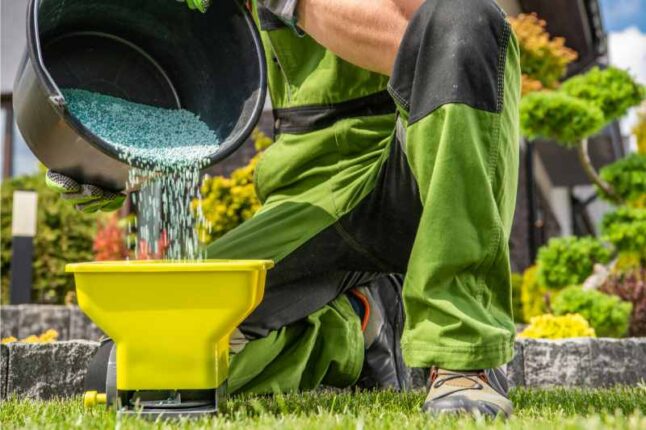
Remember to read and follow the instructions on the product label for specific guidelines and safety precautions.
Tools needed: A spreader, either a manual push (similar to a wheelbarrow) or handheld style. Here are the Best Fertilizer Spreaders to help you understand the tools you’ll need.
Pro tip: Wear a dust mask and rubber gloves to prevent skin and lung irritation from the product dust when loading the spreader. Wear long pants, socks, shoes, or even rubber boots when applying to prevent irritation from any product contact.
How to Apply Granular Pre-Emergent:
Step 1: Fill your spreader with granular pre-emergent herbicide.
Step 2: Calibrate the spreader to match the application rate on the product label. This ensures you’re not overapplying the pre-emergent herbicide.
Step 3: Apply the granular pre-emergent by walking across your entire lawn, squeezing the handle on the spreader, and spreading the granules as evenly as possible. Release the handle anywhere you don’t want to apply the product.
Step 4: Thoroughly water your lawn to ensure the herbicide can reach the seeds in the soil.
Pro Tip: Cut the recommended application rate in half and go over the same area twice. Apply the product lengthwise across your yard and then crosswise to ensure even distribution.
How to Apply a Liquid Pre-Emergent Herbicide
Pay attention to the mixing ratios, application rate, and safety precautions in the manufacturer’s instructions.
Tools needed: Some liquid pre-emergents come with a sprayer attached to the bottom that connects to your hose end and automatically dilutes the product during application. Others require mixing into your own sprayer; a handheld or backpack pump sprayer is often used.
Pro tip: Wear gloves, goggles, and a mask to protect yourself from potential exposure to the herbicide when mixing the product with water. Wear long pants, socks and shoes, or even rubber boots when applying to prevent irritation from any contact with the products.
How to Apply Liquid Pre-Emergent:
Step 1: Use a measuring cup or small kitchen scale to measure the herbicide accurately, and mix in the sprayer according to the label directions.
Step 2: Walk at a steady pace, applying the spray evenly across your entire lawn. Ensure you overlap the spray areas slightly. Move across your yard as if you’re mowing to cover the area.
Pro tip: Thoroughly clean your sprayer after each use to prevent any residue from clogging the components and affecting future applications.
How to Choose Pre-Emergent Herbicide
Different types of pre-emergents do different things. While some affect only specific weeds, others will kill any plant you put it on. Here are some things to consider before choosing a pre-emergent herbicide.
Selective vs. Nonselective Herbicides
- Selective herbicide: Formulated to prevent certain weeds (broadleaf or grassy plants) and leave other plant life alone. Selective herbicides targeting broadleaf weeds won’t damage your turfgrass.
- Nonselective herbicide: Formulated to work on all seeds. This type of product is highly effective and will prevent any new seeds from establishing — including your grass, flowers, and plants — so be careful when applying.
Which Weeds Will It Kill?
Not all pre-emergent herbicide applications will kill all types of weeds. For example, selective herbicides that kill broadleaf weeds will not kill the dreaded crabgrass — because it’s a type of grass.
- Herbicides that contain isoxaben, simazine, or oxyfluorfen, for example, kill some broadleaf weeds but are ineffective against others and against invasive grasses.
- Herbicides with the active ingredient dinitroaniline, napropamide, metolachlor, or dichlobenil will kill invasive grasses and some — but not all — broadleaf weeds.
Other popular pre-emergent chemicals include:
- Prodiamine: The active ingredient found in the popular Barricade brand pre-emergence herbicide tackles about 30 different broadleaf and grassy weeds, including the dreaded crabgrass and annual bluegrass (Poa annua).
- Oryzalin: This chemical is used in Surflan and several other brands as a broadleaf weed killer and is also effective against spurge. It has gained popularity for pre-emergent weed control on established, warm-season turf.
- Dithiopyr: Effective on about 45 grassy and broadleaf weeds, Dithiopyr is the active ingredient in Dimension and several other brands. It is one of the few pre-emergent lawn care products that have some effectiveness against weeds that have already sprouted. But it needs to be used at maximum strength for that to happen. Works for about four months after application.
A natural option: Corn gluten meal is a chemical-free weed preventer for lawns that prevents weed seeds from sprouting about 70% of the time.
Granular vs. Liquid Pre-Emergent
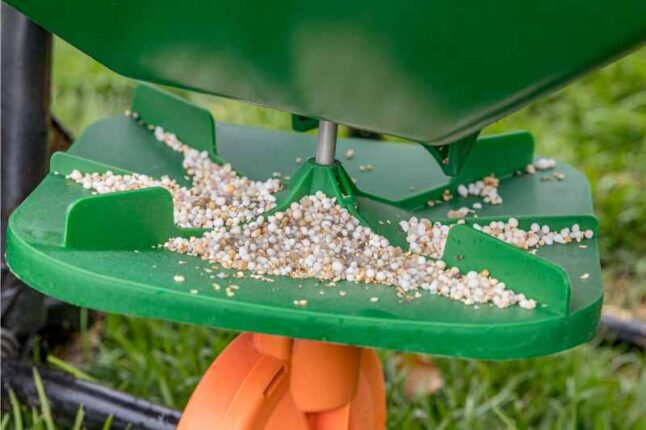
The application type is a matter of personal preference. Granular pre-emergents are often recommended for small lawns, while liquid works well for large areas. Here are a few things to consider when choosing granular vs. liquid pre-emergents.
Pros of granular pre-emergents:
- Granular is easier to apply
- Granular is typically cheaper
- There is little need for measuring and mixing
Cons of granular pre-emergents:
- Granular needs more water to become active than liquid
- It takes more work to spread evenly
- Granular works slower than liquid weed killers
Pros of liquid pre-emergents:
- Liquid works faster than granular
- Easier to distribute evenly than granular
- Requires less water to activate
Cons of liquid pre-emergents:
- Liquid pre-emergent products must be mixed carefully
- The spray may drift, killing wanted plants or grass
- It takes more time to prepare
Whichever product you select, it’s vital to apply it thoroughly and evenly to gain the best weed prevention. A pre-emergent herbicide application must cover the target area completely to serve as a barrier against weed growth. Missing a spot could mean trouble because if you give a weed an inch — it’ll take your yard!
Don’t Expect Miracles
Pre-emergent herbicides aren’t guaranteed so don’t set your expectations super high. You will not eliminate all your weeds, as herbicides may not reach all the seeds, and other seeds will be brought in on the wind, via birds, or tracked in on your shoes.
Plus, selective herbicides do not work on established perennial grasses, which will keep growing during the winter. Neither selective nor nonselective products work on existing weeds of any kind. The best solution for them is the old-fashioned hoe and spade.
“Be realistic and reasonable,” Grubbs-Bowling says. “The best defense against weeds is a healthy and competitive yard.” Proper watering, fertilizing, aerating, and mowing make your yard competitive in the war on weeds — along with patience and persistence.
Check out our comprehensive Guide to Weed Control in lawns for more information.
FAQ About Pre-Emergent Herbicides
Can Pre-Emergents Damage Your Lawn?
Some pre-emergent weed control products can hurt your turfgrass. The active ingredients of pre-emergent herbicides can damage new lawns and shouldn’t be used until the grass has settled in for a few months.
Products containing dicamba can damage St. Augustine and carpetgrass if applied at the wrong time. Also, methylated seed oil, often used in treating crabgrass, should never be used on St. Augustine, carpetgrass, Bermuda, or centipedegrass.
Should I Reseed After Using Pre-Emergent Herbicide?
Pay particular attention to the label of the pre-emergent product if you have a new lawn or intend to overseed your lawn. If you pick a variety that kills grassy weeds, it will likely kill any new desirable grass seed as well. Most pre-emergence products lose effectiveness after about six to eight weeks, so wait at least that long before reseeding.
Will Rain Wash Away Pre-Emergent Herbicide?
Heavy rain can wash away a pre-emergent herbicide if it occurs shortly after application, which can reduce the effectiveness of the herbicide in preventing weed seeds from germinating. It is essential to check the specific instructions on the product label for guidance on rain and watering after application. Also, check your weather forecast.
Call the Pre-Emergent Professionals
Homeownership is wonderful. From having your own four walls to planning your outside space as you see fit, your home is yours. But It’s not all butterflies and rainbows. Maintenance is probably the most critical aspect of keeping your property the way you want, but it’s also the most time-consuming and daunting.
But you can check one of those many to-dos off your list with some professional help to keep your lawn weed-free. Reach out to LawnStarter and we can put you in contact with local, experienced, highly-rated lawn care specialists who will take that burden off your shoulders. You can lie back and enjoy your outdoor space without breaking a sweat — or the bank.
Main Photo Credit: Yesim Sahin / Canva Pro / License
![9 Best Post-Emergent Herbicides [Reviews]](https://www.lawnstarter.com/blog/wp-content/plugins/related-posts/static/thumbs/12.jpg)
![8 Best Pre-Emergent Herbicides for Lawns [Reviews]](https://www.lawnstarter.com/blog/wp-content/plugins/related-posts/static/thumbs/25.jpg)
